Did you know that Alugbati, also known as Malabar spinach, is a leafy green vegetable packed with nutrients that are similar to those found in traditional spinach? This lesser-known cousin of spinach is gaining popularity for its health benefits and culinary versatility. Let’s explore the fascinating world of Alugbati and uncover why it’s a must-try addition to your diet.
Key Takeaways:
- Alugbati, also known as Malabar spinach, is packed with nutrients similar to those of traditional spinach.
- It is a leafy green vegetable with culinary versatility and health benefits.
- Alugbati is not a true spinach but belongs to a different plant family.
- This vegetable is rich in vitamins A and C, folate, and manganese.
- It can be found in Asian or Indian supermarkets and can be grown in your own garden.
What is Alugbati?
Alugbati, scientifically known as Basella alba, is a leafy vegetable that is often referred to as Malabar spinach. Despite having the word spinach in its name, alugbati is not a true spinach but rather a distant cousin. It is also known by other names such as mu’ er cai, vine spinach, ceylon spinach, and Indian spinach. In the Philippines, it is called alugbati, hence the name “alugbati in English.”
Alugbati is a climbing vine that produces thick, juicy leaves that can be eaten raw or cooked in a variety of dishes. With its vibrant green color and tender texture, alugbati adds a unique touch to any meal.
“Alugbati, a distant cousin of spinach, is a versatile leafy vegetable that offers a burst of freshness and flavor to your culinary creations.”
Alugbati’s Notable Names
Alugbati goes by various names depending on the region and culture:
- Malabar spinach
- Mu’ er cai
- Vine spinach
- Ceylon spinach
- Indian spinach
These names reflect the versatility and popularity of this leafy green across different cuisines and culinary traditions.
Health Benefits of Alugbati
Alugbati, also known as Malabar spinach, not only offers a delicious addition to your meals but also provides a range of health benefits. Let’s explore the nutritional goodness packed in this vibrant leafy green.
Vitamin A: Alugbati is a rich source of vitamin A, which is crucial for maintaining healthy vision, promoting strong immune function, and supporting overall growth and development.
Vitamin C: This vegetable is also high in vitamin C, an essential nutrient that plays a key role in collagen production, wound healing, and boosting the immune system.
Folate: Alugbati contains folate, a vital nutrient that supports cell growth and development, especially during pregnancy. Adequate folate intake is crucial for preventing neural tube defects in developing babies.
Manganese: Alugbati is a good source of manganese, a mineral that plays an important role in various metabolic processes, such as energy production and the formation of healthy bones and connective tissues.
By incorporating alugbati into your diet, you can reap its nutritional benefits and take a step towards improving your overall well-being.
Culinary Uses of Alugbati
If you’re looking for new and exciting ways to incorporate alugbati into your meals, you’re in luck! This versatile vegetable can be used in a variety of culinary creations, adding a pop of color and flavor to your dishes.
In Sri Lanka, alugbati is a common ingredient in curries, where its vibrant green leaves bring freshness to the dish. In the Philippines, it takes center stage in sinabawang gulay or utan, a hearty and nutritious vegetable soup. Meanwhile, in Gujarat, India, alugbati leaves are deep-fried to create a crispy and flavorful snack.
If you’re a fan of Chinese cuisine, you’ll often find alugbati used in soups and stir-fries. Its tender leaves have a slimy texture when cooked, similar to okra, making it a great addition to dishes that crave a little bit of extra moisture. For a burst of flavor, try stir-frying alugbati with ginger, creating a delicious harmony of tastes.
No matter how you choose to use it, alugbati brings a unique twist to your recipes, elevating your meals with its vibrant color and distinct flavor profile. Let your culinary creativity shine and explore the endless possibilities alugbati has to offer!
| Alugbati Culinary Uses | Country/Region |
|---|---|
| Curries | Sri Lanka |
| Sinabawang Gulay/Utan | Philippines |
| Deep-fried Alugbati Leaves | Gujarat, India |
| Soups and Stir-fries | China |
Where to Find Alugbati
If you’re looking to get your hands on some alugbati, you’re in luck! This versatile leafy green can usually be found in Asian supermarkets or Indian supermarkets. These specialty stores tend to stock a wide variety of ethnic produce, making it easier to find unique ingredients like alugbati. However, if you don’t have access to these specialty stores, don’t worry. Many people choose to grow their own alugbati in their gardens or even in pots on their balconies or windowsills.
Buying alugbati seeds online is also an option if you want to grow your own. There are several reputable online seed suppliers that offer a range of vegetable seeds, including alugbati. This allows you to have a convenient and reliable source of alugbati leaves whenever you need them.
When purchasing alugbati, whether from a supermarket or online, look for fresh and vibrant leaves. Avoid leaves that show signs of wilting or discoloration, as this may indicate that they are past their prime. The leaves should be tender and crisp, which is a good indication of their freshness and quality.
How to Cook Alugbati
Alugbati, also known as Malabar spinach, can be enjoyed in various ways – both raw and cooked. If you prefer to cook alugbati leaves, it’s important to note that they have a slightly slimy texture, similar to okra. However, this can be minimized by following proper cooking techniques.
One popular cooking method for alugbati is stir-frying. Heat some oil in a pan and add chopped garlic and ginger for added flavor. Once fragrant, toss in the alugbati leaves and stir-fry them until they become slightly wilted. You can season it with soy sauce or a dash of sesame oil for an extra savory taste.
Another way to cook alugbati is by sautéing it. Heat some oil or butter in a skillet, add the alugbati leaves, and cook them over medium heat until they become tender. You can sprinkle some salt and pepper to enhance the flavors. Sautéed alugbati can be a great side dish or a flavorful addition to your favorite recipes.
Alugbati leaves are also commonly added to soups and stews. Simply rinse the leaves thoroughly and include them in your favorite soup recipe. Let the leaves simmer in the broth until they are cooked to your desired tenderness.
Here are some cooking tips for alugbati:
- Choose fresh alugbati leaves that are vibrant in color and free from wilting or discoloration.
- Wash the leaves thoroughly under running water to remove any dirt or debris.
- Remove any tough stems attached to the leaves before cooking.
- Experiment with different flavors and seasonings to enhance the taste of alugbati.
- Be mindful of not overcooking alugbati, as it can lose its vibrant color and become mushy.
| Cooking Methods for Alugbati | Instructions |
|---|---|
| Stir-frying | Heat oil in a pan, add garlic and ginger, stir-fry alugbati until slightly wilted, season with soy sauce or sesame oil. |
| Sautéing | Heat oil or butter in a skillet, add alugbati, cook until tender, season with salt and pepper. |
| Adding to soups | Include rinsed alugbati leaves in your favorite soup recipe, let them simmer until cooked. |
“Cooking alugbati is a delightful experience that allows you to explore its unique flavors and textures. Whether stir-frying, sautéing, or adding it to soups, alugbati can be a versatile and nutritious addition to your culinary repertoire. Get creative in the kitchen and enjoy the benefits of this nutritious leafy green!”
Nutritional Facts of Alugbati
Alugbati, also known as Malabar spinach, is not just delicious but also highly nutritious. Adding it to your diet can contribute to a balanced and healthy lifestyle. Here are the nutrition facts for a 100-gram serving of alugbati:
| Nutrient | Amount |
|---|---|
| Calories | 19 |
| Carbohydrates | 3 grams |
| Protein | 2 grams |
| Fat | Less than 1 gram |
| Fiber | 1.5 grams |
| Vitamin A | Rich source |
| Vitamin C | Rich source |
| Manganese | Rich source |
| Folate | Rich source |
As you can see, alugbati is low in calories and fat, making it an excellent choice for calorie-conscious individuals. It contains a good amount of carbohydrates and protein, providing energy and supporting muscle health. Alugbati is also a fantastic source of dietary fiber, which promotes digestion and helps maintain a healthy weight.
Moreover, alugbati is rich in vitamin A and vitamin C, both essential for a robust immune system and healthy skin. These vitamins also contribute to good vision and collagen production, respectively.
In addition, alugbati provides considerable amounts of manganese, a mineral that supports proper metabolic function and bone health. It is also rich in folate, crucial for cell growth and development, especially during pregnancy.
Growing Alugbati
If you want to grow your own alugbati, you can do so by planting the seeds or using seedlings. Alugbati plants require warm weather and thrive in sunny areas with well-drained soil. The soil should have a neutral pH of 6.5 to 7.0. You can improve the soil quality by incorporating aged compost or other organic matter.
Alugbati plants are relatively easy to care for and can tolerate dry conditions, although it is important to provide them with sufficient water, about 1 inch per week. Regular feeding with a continuous-release plant food can promote better growth and a more abundant harvest.
Ready to embark on your alugbati growing journey? Here are some simple steps to get started:
- Choose a sunny spot in your garden with well-drained soil.
- Prepare the soil by incorporating aged compost or organic matter to improve its quality.
- Plant alugbati seeds directly into the soil or start with seedlings.
- Water the plants regularly, providing about 1 inch of water per week.
- Feed the plants with a continuous-release plant food to support their growth.
- Monitor the plants for pests and diseases, and take appropriate action if necessary.
- Harvest the alugbati leaves regularly to enjoy their freshness.
Growing alugbati can be a rewarding and fulfilling experience. Not only will you have a fresh supply of nutritious greens, but you will also have the satisfaction of cultivating your own food. So, get your hands in the soil and start growing alugbati today!
Troubleshooting Alugbati Growth
Alugbati plants, like any other crop, can encounter certain challenges during their growth. It’s important to be aware of these challenges and take appropriate measures to ensure the health and productivity of your alugbati plants.
Cool weather poses a hindrance to alugbati growth, as it prefers warm conditions. If you’re experiencing cool temperatures, you may notice slower growth or even wilting of the plants. In addition to temperature concerns, alugbati plants can also be susceptible to diseases such as verticillium and fusarium wilts. These diseases are soil-borne and can cause wilting and eventual death of the plants.
Another potential issue that can affect the health of alugbati plants is root knot nematodes. These microscopic, soil-dwelling pests can cause root damage and hinder the nutrient uptake of the plants, leading to stunted growth.
Pests can also pose a threat to the growth and productivity of your alugbati plants. Common pests that may affect alugbati include Japanese beetles, stink bugs, aphids, corn earworms, and flea beetles. These pests can cause damage to the leaves, flowers, and fruits, impacting the overall health of the plants.
To effectively manage these challenges and protect your alugbati plants, it is advisable to consult your regional Extension agency or a local gardening expert. They can provide guidance on disease and pest control methods that are appropriate for your specific growing conditions. Implementing preventive measures, such as proper crop rotation, maintaining healthy soil, and regular inspection for signs of pests or diseases, can contribute to the success of your alugbati cultivation.
“Prevention is the key to successful alugbati cultivation. By staying vigilant and addressing potential issues promptly, you can ensure the optimal growth and productivity of your alugbati plants.”
| Challenges | Impact | Solutions |
|---|---|---|
| Cool weather | Slower growth, wilting | Provide additional protection such as row covers or transplant when temperatures warm up |
| Verticillium and fusarium wilts | Wilted plants, eventual death | Practice good garden hygiene, avoid overwatering, and rotate crops to reduce disease pressure |
| Root knot nematodes | Stunted growth, nutrient deficiency | Choose nematode-resistant alugbati varieties, practice crop rotation, and improve soil health |
| Pests (Japanese beetles, stink bugs, aphids, corn earworms, flea beetles, etc.) | Damage to leaves, flowers, and fruits | Monitor plants regularly, remove pests by hand, use organic or chemical pest control methods as appropriate |
Harvesting and Storing Alugbati
When it comes to harvesting alugbati, timing is key. The plants typically start producing pods about 2 months after planting. For the best taste and tenderness, it’s recommended to harvest the pods when they are between 2 to 4 inches long. Leaving them on the plant for too long can result in toughness and stringiness, so it’s important to keep an eye on their growth.
One of the best ways to encourage continuous production is by harvesting the pods regularly, every day or two. This constant pruning stimulates the plant to produce more pods. To harvest the pods, simply cut them with a short stub of stem attached using pruning shears or scissors. Be cautious of the stiff leaf hairs, as they can cause itching or irritation.
If you come across any oversized pods, it’s recommended to remove them from the plant. This helps prevent the alugbati plant from exhausting itself and allows it to focus its energy on producing new pods. Regular harvesting ensures a continuous supply of fresh alugbati for your culinary creations.
| Harvesting Tips: | Storage Tips: |
|---|---|
| – Harvest pods when 2-4 inches long | – Store alugbati in the refrigerator |
| – Regularly harvest every day or two | – Place the stems in water like cut flowers |
| – Use pruning shears or scissors to cut the pods | – Keep them refrigerated for up to a week |
| – Remove oversized pods to promote continuous production | – Blanch and freeze alugbati for long-term storage |
Proper storage is essential to keep your harvested alugbati fresh. Store the leaves in the refrigerator to maintain their crispness. To extend their shelf life, you can place the stems in water, similar to cut flowers. This keeps the leaves hydrated and prevents them from wilting. Alugbati can be stored in the refrigerator for up to a week.
If you have a surplus of harvested alugbati, you can also consider blanching and freezing it for long-term storage. Blanching helps preserve the color and texture of the leaves. After blanching, pack the alugbati in airtight containers or freezer bags and store them in the freezer for future use.
Conclusion
Alugbati, or Malabar spinach, is a versatile and nutritious leafy green that can be incorporated into a wide range of dishes. With its abundance of vitamins A and C, folate, and manganese, alugbati offers numerous health benefits. Whether enjoyed raw in salads or cooked in soups and stir-fries, its tender leaves provide a delightful texture and flavor profile.
You can easily find alugbati in Asian or Indian supermarkets, or even grow it in your own garden. By following proper planting and care techniques, you can cultivate a thriving alugbati crop and enjoy a bountiful harvest. Embrace this cousin of spinach and unlock its delicious flavors and nutritional goodness in your meals.
Switch up your greens and give alugbati a try today. Your taste buds and your body will thank you for incorporating this nutrient-packed leafy green into your diet. Discover the delights of alugbati and elevate your culinary creations with its vibrant and healthful qualities.










Leave a Reply